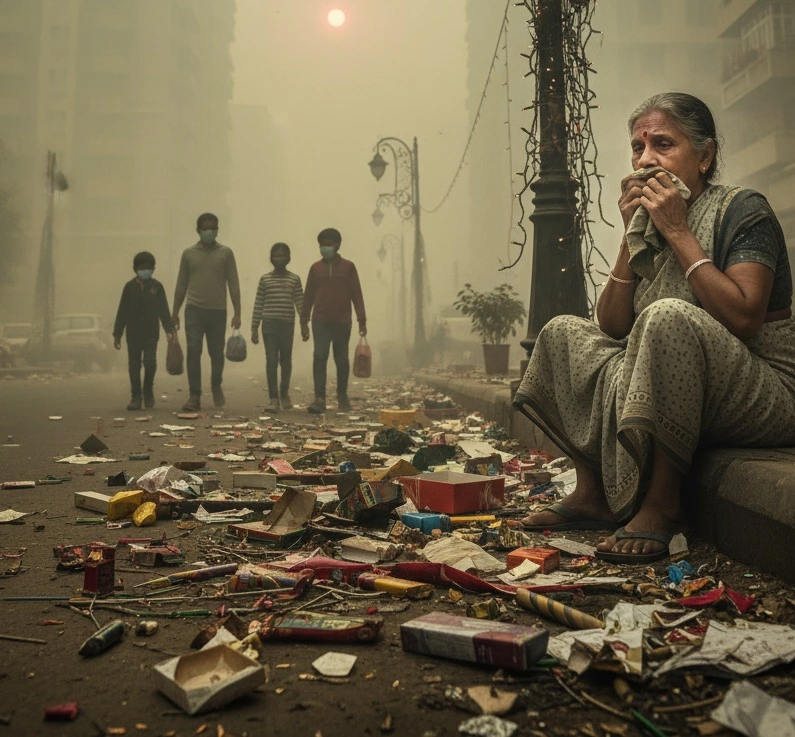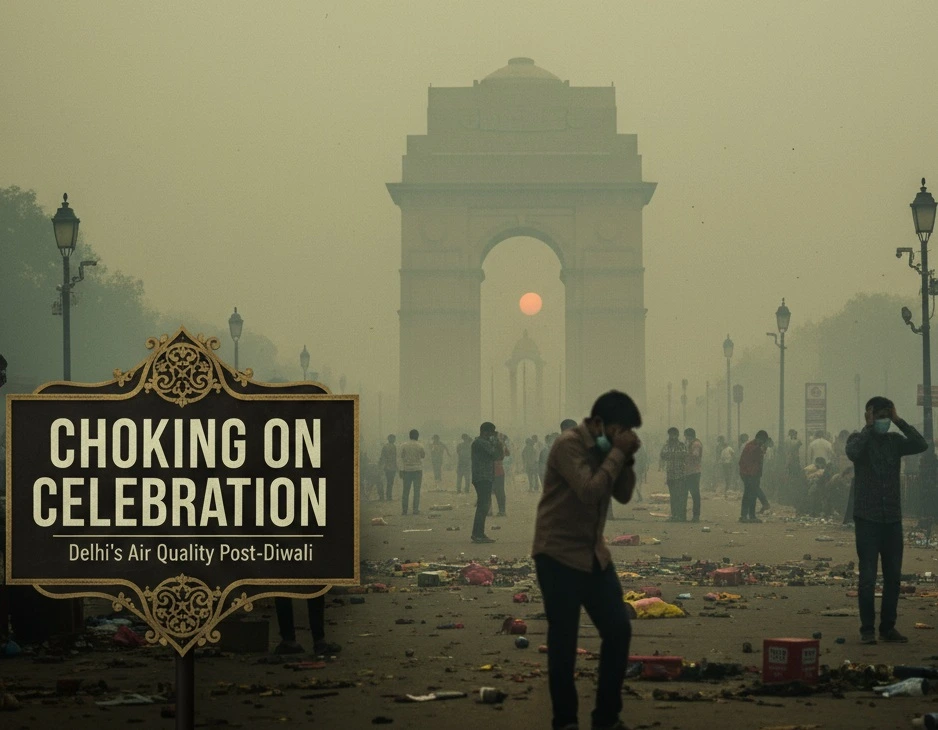When the Sky Dims Amid Festival Lights
Every year, as the festive lights of Diwali fade, the skies over the Delhi region betray a far darker scene. Spectacular bursts of fireworks and cracker-cracking may fill the streets with cheer, but they also send the city’s air into a steep decline. This year is no different, just two days after Diwali, we’re witnessing alarmingly high pollution readings across Delhi and neighbouring areas. In this blog, we’ll walk you through what AQI means, where Delhi stands right now, what health risks it brings, why the problem recurs in the NCR region and what you and the city must do to cope.

What Is AQI — The Air Quality Index Explained
When you hear that Delhi’s air quality index (AQI) hit “very poor” or “severe”, what’s that measuring exactly?
- The Air Quality Index is a composite scale (commonly 0–500 in many systems) designed to communicate how polluted the air is and what health risks it may carry.
- It takes into account key pollutants, fine particulate matter (PM2.5), coarse particles (PM10), nitrogen dioxide (NO₂), sulphur dioxide (SO₂), carbon monoxide (CO), ozone (O₃) among others.
- Importantly – the highest pollutant reading often determines the AQI value at a given time — so even if most pollutants are moderate, one high-pollution component can push the AQI into “unhealthy” or “hazardous”.
- Typical category thresholds:
- 0-50: Good
- 51-100: Satisfactory
- 101-200: Moderate to Poor
- 201-300: Very Poor / Unhealthy
- 301-500+: Severe to Hazardous
So when you hear Delhi’s AQI at, say, 345 or more, it means there’s serious risk for health and daily life.
Current Air Quality Status in Delhi & Nearby Areas
Here’s a snapshot of what’s happening right now in Delhi and its surroundings post-Diwali:
- According to official reports, Delhi’s 24-hour average AQI climbed to “very poor” zone at about 345.
- One news source reports reading of ~350 for the capital.
- Data from a real-time map showed: PM2.5 around 223 µg/m³ and PM10 about 337 µg/m³ in Delhi — extremely high compared with safe limits.
- Another live dashboard reported AQI values above 300 for New Delhi, with locations seeing “Severe” or “Hazardous” categorisation (e.g., Ashok Vihar: ~384) on the day after Diwali.
- For nearby places in the NCR (National Capital Region) too, smog and stagnant air mean high readings and widespread “red-zone” stations. For example: 34 of 38 monitoring stations in Delhi were in the red zone on Diwali evening.
In short, the air in Delhi right now is very poor to severe and for many areas likely bordering on hazardous. The numbers suggest serious pollution levels — far above safe thresholds.
What These Numbers Indicate — How Bad Is It?
When AQI hits those levels, it’s not just a “bad day” for visibility, it indicates the air is carrying pollutants at concentrations that can cause immediate harm.
- PM2.5 and PM10 are especially dangerous: fine particles can penetrate deep into lungs (and bloodstream), making it harder for the body to clear them.
- When AQI > 300, the category is “Severe / Hazardous” (in many indices) meaning all people may experience health effects, sensitive groups (children, elderly, people with lung/cardiac conditions) are at high risk.
- The readings we are seeing for Delhi (PM2.5 200+ µg/m³, PM10 in the hundreds) are many times higher than WHO recommended levels for safe air. E.g., one metric put PM2.5 ~ 44.6 times WHO annual guideline.
- The smog also suggests stagnation of air, low wind, possibly favourable conditions for buildup of pollutants (which we talk about in next section).
Thus, yes — it’s very bad. The air is unhealthy for all, dangerous for many. It’s not something to be ignored or considered “just a little smog”.
Health Impacts: What This Means For You and Me
When air quality deteriorates like this, it has real effects on health — both short-term and long-term.
Short-term effects
- Irritation of eyes, nose, throat. Coughing, wheezing.
- Exacerbation of asthma and bronchitis in people who already have lung issues.
- Difficulty breathing during physical activity.
- Increased visits to hospitals for respiratory issues and heart problems.
- For kids and elderly: higher risk of infections, exacerbation of chronic conditions.
Long-term effects
- Repeated exposure to high PM2.5 over months/years is linked to cardiovascular diseases, lung cancer, reduced lung function.
- Premature death in severe cases.
- Impact on children’s development – lung growth, cognitive effects.
- For entire population – increased healthcare burden, lower quality of life.
Given the readings we’re seeing in Delhi, these risks are not hypothetical—they are very real. During such pollution episodes, even healthy individuals are advised to avoid strenuous outdoor activity and consider precautionary measures.
Why Does This Keep Happening in Delhi & NCR?
Why is the region stuck in this annual cycle of deteriorating air quality? A few key reasons:
- Geography + meteorology
- Delhi and neighbouring regions lie in the Indo-Gangetic plain, which during winter has a tendency for cooler air near the surface and an inversion layer above. Pollutants get trapped, low wind means less dispersion.
- Dry conditions, low wind, fog/smog all contribute to accumulation.
- Multiple pollution sources
- Festival celebrations – firecrackers/ fireworks add a sudden large spike of particulate matter. Reports show Diwali causes measurable surge.
- Stubble burning in neighbouring states (Punjab, Haryana) adds plumes of smoke that drift into Delhi-NCR.
- Vehicle emissions, construction dust, industrial emissions, power generation all work year-round.
- In winter, domestic heating and burning of biomass/coal (in some areas) adds to load.
- Delayed response + stagnant conditions
- The system of monitoring and enforcement, while improving, still struggles to prevent build-up of pollutants at source.
- Also, once pollutants accumulate, meteorological conditions make it hard to clear them quickly—so bad air stays for days.
- Urbanisation and population
- High density of vehicles, frequent construction, high energy demand all contribute.
Because of this mix of bad weather, many pollution sources and structural issues, Delhi-NCR sees one of its worst air quality periods following Diwali, extending into winter each year.
What Needs to Be Done (Systemic & Individual)
Fixing this isn’t just about individual behaviour — though that helps. Broadly, action is needed at two levels.
Systemic / policy level
- Strong enforcement of bans/limits on firecrackers in festival periods.
- Strict monitoring and enforcement of industrial emissions, construction dust controls, vehicle pollution standards.
- Tackling stubble burning, providing alternatives, enforcing against burning, supporting farmers.
- Improving public transport, reducing reliance on private vehicles.
- Urban planning – increasing green cover, open spaces, dust mitigation.
- Early warning systems & rapid response when air quality worsens (e.g., subsidised masks, shifting outdoor events, school-outdoor activity restrictions).
- Enhanced monitoring and transparency so the public is aware and agencies are accountable.
Individual / household level
- On days when AQI is “Very Poor” or worse, limit time outdoors. Avoid strenuous exercise outside.
- Use N95/KN95 masks if you must go out when air quality is bad.
- At home: keep windows closed if outside air is heavily polluted; use an air purifier if you can.
- Avoid burning solid fuels or trash. Promote clean-fuel cooking/heating.
- For children, elderly or people with respiratory/cardiac conditions – extra caution essential.
- Stay updated via AQI apps/websites, plan activities accordingly.
Final Thoughts
The post-Diwali air quality crisis in Delhi is not just a temporary inconvenience—it is a serious public health issue. With AQI readings climbing into “Very Poor”, “Severe” or even “Hazardous” levels, and fine particulate concentrations many times above recommended limits, the air we breathe is unsafe for a large portion of the population.
For residents of Delhi and the broader NCR region, this means taking personal precautions and demanding systemic change. The festive season’s sparkle should not come at the cost of our lungs, our children’s health, or our city’s future.
Let’s hope that the immediate crisis prompts wider reflection, better policy and stronger collective action — because clean air is not just a luxury, it’s a basic right.
By combining structural change and personal vigilance, the impact of such pollution episodes can be reduced (though elimination will require a sustained effort).
For more Health and Lifestyle Updates, Follow Popnewsblend.com

Hi, I’m Prashant Jain — a curious soul, storyteller, and content creator at heart.I’ve always been drawn to the world of entertainment, travel, sports, health & lifestyle — not just as a writer, but as someone who genuinely lives these experiences. Whether I’m binge-watching the latest OTT series, exploring offbeat spiritual destinations in India, or diving deep into wellness routines and cricket match insights, I love sharing what I discover with like-minded readers.
PopNewsBlend is my way of blending personal journeys with meaningful stories — ones that inform, inspire, and keep you ahead of the curve. Everything I write comes from real observations, hands-on experiences, and a deep passion for understanding the world around us.
Discover more from Popnewsblend
Subscribe to get the latest posts sent to your email.








🌆 Delhi never fails to amaze! From historic monuments like the Red Fort and Qutub Minar to bustling markets and amazing street food, the city is a perfect blend of tradition and modernity. Every corner tells a story! 🇮🇳✨ #Delhi #IncredibleIndia #CityLife